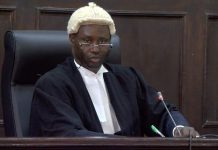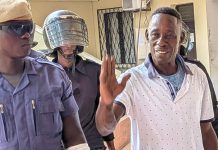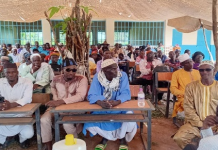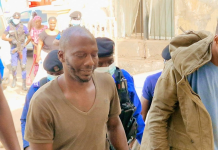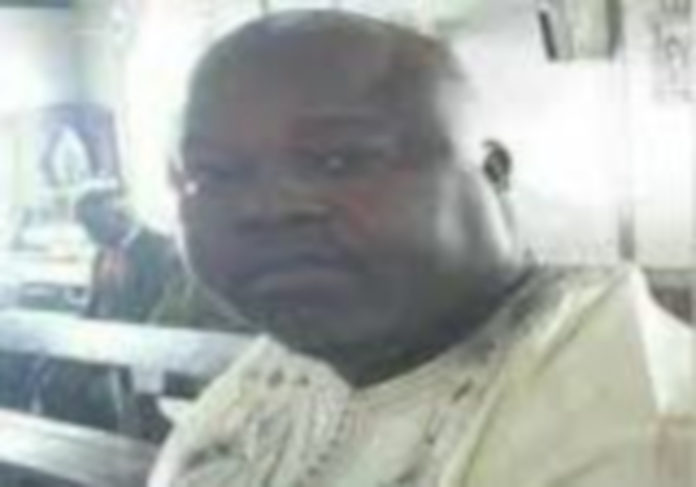INTRODUCTION
The purpose of this inquest is to look into the circumstances surrounding the death of Louise Gomez at the EFSTH. Louise Gomez was a former Deputy Director General of the erstwhile National Intelligence Agency (NIA). He was a remand prisoner at the Central Prisons Mile ll.
On the 16th of October 2018, The Chief Justice of The Gambia, Justice Hassan B, Jallow assigned me as Coroner Pursuant to the Coroners Act Cap 7:04 Volume ll Revised Laws of The Gambia 2009.
A public announcement was made informing the general public that the Chief Justice has appointed a coroner to establish the cause of death of the late Louise Gomez. By this announcement, the media, family of the deceased and the general public were all put on notice. l summoned several persons to give account of their interaction with the deceased, from when he was remanded at Mile ll up to the time of his death and subsequent postmortem.
THE FACTS OF THE INQUIRY
The venue of the inquest was at the main court room at the Banjul Magistrates Court. The proceedings were open to the general public.
PERSONS INVITED TO GIVE EVIDENCE
- Ansumana Manneh – Director General of Mile ll Prisons
- Fanta Sanneh – Medic at Mile ll prisons.
- Alhagi K. Manneh – Police Serious Crime Unit
- Lamin Fatty — Police Scientific Unit
- Elizabeth Sophie Ndow – Physician at EFSTH
- Armando Correa – Physician at EFSTS
- Franklin Perry – Chief Pathologist at EFSTH
The main areas of this inquiry are as thus:
- The known medical history of the deceased:
- The treatment he received:
- The post mortem report as to the medical cause of death.
On the 25th October 2018, I invited the Director General of Prisons to give an account of how the deceased was remanded and to give an overview of the general condition at Mile ll Prison.
STATEMENT OF ANSUMANA MANNEH, DIRECTOR GENERAL OF MILE LL PRISONS:
He stated as follows: –
He enlisted in the Gambia Prisons Service in 1988. He rose through the ranks and became theDirector in February, 2017.
He gave a brief description of the Remand Wing, The Main Yard, The Security Wing and The Female Wing. He further stated that the Juvenile Wing is situated at Jeshwang Prison.
Sometime in 2017, the deceased and other accused persons were brought to Mile ll and were placed in the Remand Wing. They were later transferred to the Security Wing in accordance to Section 36 (2) paragraph (f) of the Prisons Act. He stated that the Remand Wing was built to accommodate six inmates for each cell. Due to overcrowding, each cell now accommodates ten inmates. The Remand Wing has a total of eleven cells.
He went further to say that he instructed the commissioner of operations to move some of the inmates to the security wing. They were kept at the security wing until he received an order from the High Court to return them back to the Remand Wing. Thereafter, he received information that Louise Gomez had passed away. Upon receiving information about the death of the deceased, he instructed the medic to proceed with the necessary processes.
Further, to his testimony, he also stated that the cells are approximately 2 metres square.
STATEMENT OF FANTA SANNEH: THE MEDIC AT MILE LL PRISONS:
- She stated as follows: –
She is the medic at the Mile ll Prisons. She enlisted at the Prison Services in 2003 and became a medic in 2005 after acquiring some training. When she came into contact with the deceased, he told her that he was a known hypertensive patient and had been diagnosed with CCF – Congestive Cardiac Failure. Other visiting doctors also come to the prisons to treat the inmates.
She stated that before the deceased passed away he complained about general body pain. The deceased was treated for general body pain. A week before the deceased passed away, he came to the clinic around 2:00pm and told her that he was still having body pain and that it could have been malaria. He was tested for malaria and the results came out negative. The HAEMOGLOBIN of the deceased was 14% and blood pressure was Ok. She opted to refer him to the EFSTH. At the time, his blood pressure was normal. The deceased was taken to the EFSTH by the nurse and prison security. He was tested at the hospital. His RTD for malaria was negative. His HAEMOGLOBIN was 14.0 and his BP was normal, consistent with the test conducted at the prison clinic. The only thing they prescribed at the hospital different from what was prescribed at the prison clinic was that he was given Vitamin C. He was sent back to Mile ll Prison. The deceased told her that he already had Vitamin C.
She suggested to transfer the deceased to the infirmary because it has better space. The deceased told her that the condition at Remand is not conducive because of cigarette smoke and other nuisances.
The Infirmary is a place where inmates coming back from the hospital are kept before they are taken back to their cells. Later, she received a call informing her that Mr. Gomez was complaining about difficulty in breathing.
She told her juniors to rush the deceased to the hospital. The deceased passed away some fifteen minutes upon arrival at the hospital. She was instructed to find out about the cause of death and she proceeded to the hospital.
She was given a BID (brought in dead) certificate and was told that the deceased died a few minutes upon arrival at the hospital. The death certificate was admitted and marked as EXHIBIT “A”. The handing over of the body certificate was admitted and marked as EXHIBIT “B”.
STATEMENT OF ALHAGI K MANNEH: POLICE OFFICER ATTACHED TO THE SERIOUS CRIMES UNIT:
On the 29 October, 2018, I summoned Alhagi Manneh to testify. He stated as follows: –
He knows the deceased from the time he was Deputy Director of the National Intelligence Agency. He was part of the investigators into the death of the deceased.
On the 6th of October 2018, he was informed that Louise Gomez had passed away at the hospital and that the remains were taken to the mortuary for post mortem. He proceeded to the mortuary where he met with Prison Medic Fanta Sanneh, the family of the deceased, Dr. Franklin Perry, Dr Amando Correa and PRO Lamin Jammeh.
The Infirmary is a place where inmates coming back from the hospital are kept before they are taken back to their cells. Later, she received a call informing her that Mr. Gomez was complaining about difficulty in breathing.
She told her juniors to rush the deceased to the hospital. The deceased passed away some fifteen minutes upon arrival at the hospital. She was instructed to find out about the cause of death and she proceeded to the hospital.
She was given a BID (brought in dead) certificate and was told that the deceased died a few minutes upon arrival at the hospital. The death certificate was admitted and marked as EXHIBIT “A”. The handing over of the body certificate was admitted and marked as EXHIBIT “B” .
STATEMENT OF ALHAGI K MANNEH: A POLICE OFFICER ATTACHED TO THE SERIOUS CRIMES UNIT:
On the 29 October, 2018, I summoned Alhagi Manneh to testify
He stated as follows: –
He knows the deceased from the time he was Deputy Director of the National Intelligence Agency. He was part of the investigators into the death of the deceased.
On the 6th of October 2018, he was informed that Louise Gomez had passed away at the hospital and that the remains were taken to the mortuary for post mortem. He proceeded to the mortuary where he met with Prison Medic Fanta Sanneh, the family of the deceased, Dr. Franklin.
Perry, Dr Amando Correa and PRO Lamin Jammeh.
He also called on the photographer from the Police Criminal Records Office Mr. Lamin Fatty to take pictures.
The family of the deceased were represented by One Mithell Gomez and Ambrose Mendy. The former is the wife and the latter is the brother of the deceased. They identified the body as that of the deceased before the post mortem was conducted. Dr. Perry and Dr. Correa proceeded to conduct the post mortem while the CRO officer Lamin Fatty took pictures.
After the post mortem, a death certificate of the deceased was prepared by Dr. Amando Correa. Dr. Correa gave the death certificate to the prison Medic Fanta Sanneh.
STATEMENT OF LAMIN FATTY: POLICE OFFICER ATTACHED TO THE CRO (CRIMINAL RECORDS OFFICE):
- He stated as follows: –
He is a police officer attached at the scientific support Unit. He is the photographer who took pictures of the post mortem. On the 16th of October 2018, he was informed about the death of the deceased and was told to proceed to the EFSTH to take pictures of the post mortem. The pictures were admitted and marked as EXHIBIT D.
On the 8th of November 2018, l summoned Dr. Elizabeth Sophie Ndow Statement of Dr. Elizabeth Sophie Ndow: A physician at the DFSTH.
- She stated as follows: –
On the 11th of October she was the physician on call at the emergency unit at the EFSTH. While she was on duty, the deceased was rushed in by uniformed men. The condition of the deceased was such that it was declared an absolute emergency.
At that material time, she was attending other patients but had to abandon everything to attend to the deceased. The deceased had severe respiratory distress and was gasping for air.
He was CYANOSED and turned blue (Respiratory Failure). The mucus membrane of the deceased turned blue. The deceased had low oxygen so they. had to put him on oxygen. His oxygen saturation was 43%; the normal oxygen saturation is between 93% to 100%.
The referral papers from the prisons stated that the deceased was an Asthma patient. She could not diagnose the deceased at the time so she had to treat the deceased for severe Asthma attack. She gave him SALBUTAMOL to open up the bronchial tree. She also gave him an anti-inflammatory HYDROCORTISONE. The condition of the deceased was worsening. The oxygen saturation kept dropping. The deceased started gasping for air. His pupils where dilated but there was still cardio pulmonary activity. About ten minutes later, the heart stopped beating.
They started physical cardio pulmonary resuscitation (CPR) for about ten minutes. The CPR could not revive him and thereafter, they pronounced the deceased dead.
Counsel Patrick Gomez (Lawyer for the family ) asked Dr. Ndow to shed light on some of the factors that may trigger an Asthma attack. The Dr. stated that poor ventilation, smoke, dust, and respiratory tract infection are some of the triggers that may cause an Asthma attack.
On the 25th of October 2018, l summoned Dr. Franklin Perry to testify.
Statement of Dr. Franklin Perry: Pathologist at the EFSTH.
- He stated as follows: –
He is the Doctor that performed the autopsy on the deceased. He had been a Physician for 55 years. The body was brought for autopsy on the 16th October 2018. They received the body of a middle aged man wearing jeans. The body was received in the presence of the forensic team comprising Mr. Alhagi Manneh from the police, Dr. Armando Correa, Fanta Sanneh from the prisons, and the police cameraman Mr. Lamin Fatty.
They examined the body of the deceased. The body was that of an obese man. Physical external examination showed no external injuries. They proceeded to open the THORACIC PART of the body and they observed that the heart was enlarged. When they opened the heart, they saw that the muscular wall was measuring 2.5 centimeter in the left ventricle of the heart. The right ventricle was measuring 1.8 cm.
All the activities of the heart were dilated and there was presence of blood clot in contact with the pulmonary artery.
They proceeded to inspect the lungs. Both left and right lungs were irregular. The texture was hard. They cut a section of the lung and it was HAEMORRHAGED. With that, they had a clue of the cause of death.
They inspected the liver and found out that it was also irregular with NODULAR SURFACE – that means that there was presence of congestion for a long time.
With all the above findings, they established why the death was so sudden.
They concluded that the primary cause of death was PULMUNARY THROMBOEMBOLISM, a primary cause of death in more than 95% of the cases involving THROMBOEMBOLISM.
The secondary cause of death is HYPERTENSIVE CARDIOMYOPATHY.
The post mortem report was admitted and marked as EXHIBIT “C”.
ln clarifying questions raised by the Lawyer for the family of the deceased, Mr Patrick Gomez Esq. Dr., Perry explained that PULMONARY THROMBOEMBOLISM is a condition wherein blood clot travels through the pulmonary artery to the lung.
Dr. Perry further stated that PULMONARY THROMBOEMBOLISM is a cause of death in 95% of patients with similar conditions and that even with the best of treatment, most patients don’t survive.
Answering to the question of whether there is a treatment for the condition, the Dr. stated that only about 3% of patients survive even in the best of modern hospitals.
Statement of Dr. Armando Correa: Physician at the EFSTH
- He stated as follows: –
On the 16th October 2018, the body of a middle aged man was brought to the mortuary. They noticed an obese man who was dressed in Jeans. They did not notice any external injury.
They opened the chest and inspected the THORACIC ORGAN and notice that there was a massive enlargement of the heart.
They noticed that the heart chambers were dilated and the muscular walls of the heart were increased. They examined the lungs and noticed that the lungs were increased. They noticed that the lungs were HAEMORRHAGED and also noticed that the liver was increased.
With that they concluded that the Primary cause of death was PULMONARY THROMBOEMBOLISM. They concluded that the secondary cause of death was CARDIOMYOPATHY.
ANALYSIS OF THE EVIDENCE
While keeping in mind that the purpose of a Coroner’s inquest is to determine the cause of death, the Coroner may make recommendations.
The testimony of the Prison Medic is that the deceased was a known cardiac and hypertensive patient. Her evidence did not indicate that the clinic at the prisons has any adequate facilities to deal with inmates with chronic ailments.
The testimony of Dr. Elizabeth Sophie Ndow is that the situation of the deceased at the time of arrival at the hospital was dire. He had low oxygen saturation of only 43% where the normal oxygen saturation is between 93% and 100%. The fact that the deceased was already gasping for air indicated that she was dealing with an absolute emergency.
The testimony of the Director of Prisons is that the cells are overcrowded and that the deceased was transferred to the security wing. The reason for the High Court order for the deceased and his co-accused to be returned to the regular remand wing must have been for positive benefits and not for negative reasons. It is a testament that the remand wing is preferred over the security wing.
The testimony of Dr. Franklin Perry and Dr. Amando Correa is that they received the body of an obese patient. When they looked into the vital organs of the deceased, they realized that the deceased had an enlarged heart, dilated cavities and hemorrhaged lungs.
VERDICT
It is the evidence of the pathologist and the assisting doctors that there were no external injuries or any other external factors. Without any evidence to the contrary, I hold that the cause of death of the deceased is consistent with the findings of the pathologist that:
- a) The primary cause of death was PULMUNARY THROMBOEMBOLISM
- b) The secondary cause of death was CARDIOMYOPATHY
Malafy Jarju Esq. VM,
Acting Principal Magistrate
Banjul Magistrates Court
Coroner: 7th December 2018

